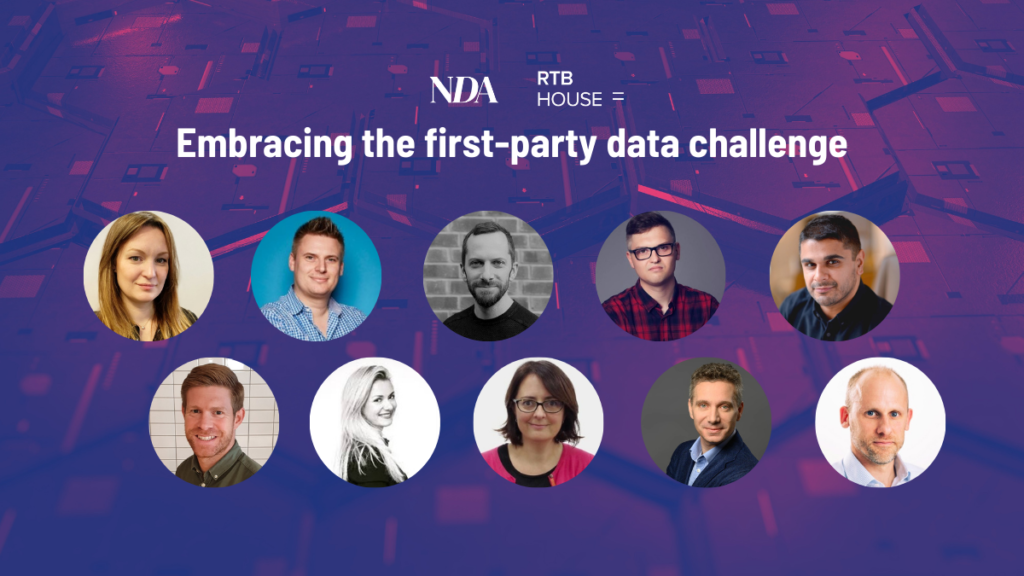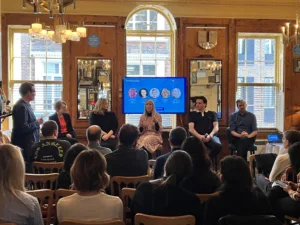The deprecation of third-party cookies has significantly increased the importance of first-party data to marketers, as they search for alternative ways to target and measure their campaigns. New Digital Age, in association with RTB House, recently hosted a roundtable discussion of industry experts from across the digital ad ecosystem to find out how well brands, agencies and publishers are dealing with this shift.
NDA’s editor-in-chief Justin Pearse hosted the session, and was joined by Olya Dyachuk, Data Driven Media Director, Heineken; Paul Bland, Head of Biddable Media, Havas UK; Tim Lawrence, Senior Director Digital, Data and Technology, Starcom; Kevin Joyner, Director of Data Strategy, Croud; Nav Dhillon, Head of Advertising, Gumtree; Jo Holdaway, CDMO for Independent Digital News and Media ( IDNML); Piers North, CRO, Reach Plc; Clare Ritchie, Global Head Of Programmatic, Mediacom, MediaCom; plus Łukasz Włodarczyk, VP of Programmatic Ecosystem Growth & Innovation, and Simon Trewavas, Country Manager, UKI, both of RTB House.
Holdaway of IDNML opened the discussion by asserting that, from a publisher perspective, the need to boost first-party data resources represents a “win-win”. She said: “It obviously provides us with an alternative post-cookie monetization strategy but it also helps us to deepen our relationship with our readers. Cookie deprecation has given marketers leverage to say to their boards we now need to ramp up our first-party data acquisition and get much more support than they would have previously. I think there is definitely still a market for third party data, though, if it is collected transparently and used ethically.”
Reach’s Piers North made the point that publishers are often ones facing the sharp end of privacy protections for consumers. He said: “Ask a consumer if they want to be tracked all over the internet and they’ll tell you no. Ask them if they want more relevant ads and they’ll say absolutely yes. As a publisher that’s predominantly ‘free-to-air’ it’s a difficult conundrum for us. Putting content behind paywalls would certainly help us capture more first-party data but would also price some of our audience out of the market. Marketers need to understand that the shift away from free-to-web advertising poses a substantial risk for the entire digital ad and media ecosystem. It’s frustrating that companies such as Apple know more about consumers than publishers ever will, yet we are usually the ones on the kicking end of the privacy debate.”
Dyachuk of Heineken explained that, in most cases, FMCG businesses will never have an opportunity to collect as much first-party data as retailers or publishers. She said: “We’ve spent the last few years finding ways to collect customer data, for example, working with pubs to fund free wi-fi. I believe that a business like ours cannot survive on first-party data alone, so we need a balanced data strategy that has a clear role for first, second, third and zero-party data. We’re also building strong relationships with our retail partners, to make sure we have access to insights via shopper data.”
Dychuk believes that cookie deprecation has accelerated the digital transformation agenda more generally: “Traditionally, senior business leaders can get scared by conversations about data, but when you talk about the need to drive positive business outcomes and better customer experiences, it becomes easier to secure management buy-in. It’s also been fascinating to see how much more engaged the brand teams are with data and digital, which is brilliant.”
Offering an agency perspective, MediaCom’s Clare Ritchie said: “Every single client of ours has a different challenge around first-party data, because ultimately, first-party data and zero-party data are value exchanges. There needs to be a reason for a consumer to give away their data and, with some clients, there’s little incentive. As marketers, though, I think it’s a valuable exercise for us to be spending time enhancing, cleaning, understanding and really educating ourselves and others on how to use first-party data accurately, rather than simply taking a data set, pushing it into a DSP and activating on it.”
Tech talk
Joyner explained that Croud has been very interested in first-party data for some time and not simply because of the loss of third-party identifiers. He said: “It goes hand-in-hand with tech developments in the industry, such as machine learning and deep learning delivering improvements in bidding tech, and many of our clients are really interested in exploring those more. Of course, these advancements are available to everybody who advertises, meaning the playing field is more level than it used to be. As a result, first-party data and the way that we activate it has become one of our new best levers for competition. That means we’ve got to look for every opportunity to squeeze some value out of the data that’s unique to the advertiser.”
Trewavas of RTB House agrees that there is a “democratisation of data” going on at the moment: “When you look at the solutions being proposed in Google’s Privacy Sandbox, many of them will provide data that wouldn’t previously have been enabled to everyone. At RTB House, we’ve spent a lot of time looking at how brands and their agencies can work with first-party data and have actually two proposals of our own adopted by Google’s Fledge API focused on understanding the consumer in a privacy compliant way. For brands, publishers and consumers, there’s an interesting tension between personalisation and privacy right now and we believe that Deep Learning will be crucial to making the most of first-party data.”
Nav Dhillon of Gumtree believes the current changes to the digital ad ecosystem will see many publishers rationalize the volume of tech partners they work with. He said: “In recent years, it’s been about onboarding more partners and trying to drive as much yield and revenue as possible, but I think we’ve reached a plateau where we’re seeing a lot of cannibalization between what various tech partners can offer. We now need to understand the value and knock-on effects of different partners when it comes to consumer experience and the latency impacts on our platform. Moving forward, it’s about quality and consolidation of partners rather than simply more and more.”
The brand challenge
Does the shift to first-party data represent a particular challenge for branding campaigns where scale and reach are often regarded as primary concerns?
Havas UK’s Paul Brand said: “There are definitely some technical challenges around frequency and around understanding reach but, then, cookies were never a particularly good tool for brand campaigns anyway. I think the latest trends in the marketplace are bringing activation closer to the planning process. What’s more, we have the chance to infuse that planning process with better digital and data signals that let us understand different platforms, different publishers, different websites, in detail. The loss of cookies is pushing us towards methodologies that will actually allow us to both activate and measure brand in better, more effective ways.”
Starcom’s Tim Lawrence agrees that cookies were always of limited value to brand campaigns. He said: “Branding has never been about the sort of hyper-personalization that third-party cookies enable. Generally speaking, broad audiences are needed to deliver strong brand results. I think it’s a positive move that even our FMCG clients are looking seriously at first-party data and trying to understand those broad audiences in more detail.”
Włodarczyk of RTB House added: “At this stage, I think brands should be asking themselves what will be the cost of not using Deep Learning, i.e. a fully autonomous solution, for their media planning and activation. It may still be possible to run an effective campaign without it, but it will become more and more expensive due to the increasing complexity of the marketplace. Post-cookie methods can be classified into three main groups: things like Fledge API and Topics API, based on targeting groups of people; identity solutions that target individuals; and contextual targeting. I think leveraging all three will require a powerful combined solution and, for me, that means Deep Learning.”









